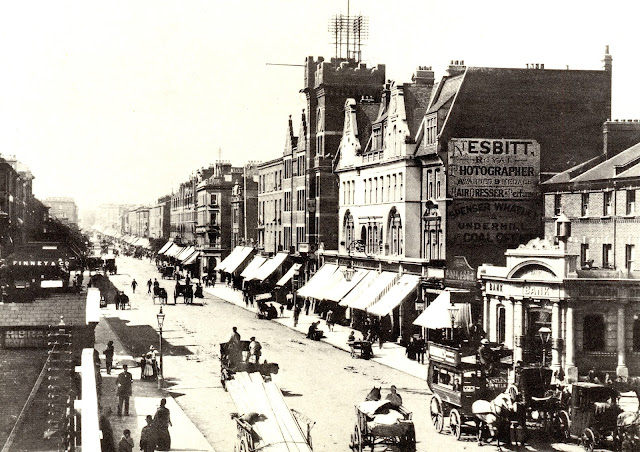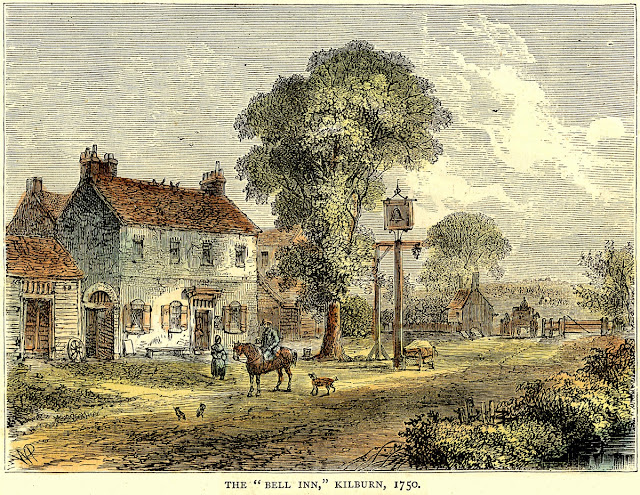By day an accountant’s
clerk and by night, a professional bicycle rider, debonair man-about-town and a burglar,
the highly versatile Frederick Monks was sentenced to twelve months’
imprisonment for robbery in 1904. At the time he was the only man ever known to
the London Police who had lived a ‘quadruple life’ and his story is a romance
of roguery. He lived four widely divergent lives, mingled in four different
classes of society, had four sets of friends, and maintained four
characteristics. He was arrested in his lodgings in Kilburn Park Road (no number was given in the reports).
The
Clerk
In the morning
Frederick Monks, dressed like all the other clerks, took a seat at his desk in Wilson and Co.
a firm of accountants at Nos.37 and 39 Essex Street, Strand. His demeanor was modest and unassuming. He was
deferential to his employers and congenial with his colleagues. He ate his
modest lunch alongside them, chatting about girls and sport - subjects which
clerks often talked about. ‘That bicycle rider?’ he would say in response to
the good-natured banter of his friends who asked him about the professional
athlete who had won the three-mile race at the ring the evening before. ‘No, I
don’t know him. He’s no relative of mine, even if his name is Frederick Monks. If
I could win £50 for riding around a race track in eight minutes, do you think I
would add up figures for 35 shillings a week? Not me!’ At the end of the work
day Frederick Monks would close his ledgers, carefully hang his threadbare office
coat on a peg, and leave the office to catch a bus to Kilburn Park Road where he rented a single room.
The
Athlete
Fred trained at a
gymnasium, where he put himself through an hour’s hard exercise with dumbbells,
weights and pulleys, and Indian clubs. Then after a shower bath and a rub down,
he would don a suit of riding tights, put on his outer clothes and a heavy
sweater, and go to the Paddington Recreational Ground. There he would ride his
bicycle for an hour. A sponge bath, another rub down, this time by his trainer,
a substantial supper, and Frederick Monks, professional rider, was ready for a
race. At the gymnasium and in the riding rink Frederick Monks was no longer the
modest, unassuming clerk. He was loud-voiced, hearty, bluff and a good fellow.
He swore much, drank nothing, and smoked a little. No one dreamed that he could
and did transform himself into a humble bookkeeper during the working day. Frederick
Monks was well known in sporting circles in London and his name often appeared on the sports pages.
He won many races and was undisputed champion of his class.
Man
about Town
On the evenings when
Monks was not riding in a race or training he adopted his third persona. His
dress suit, top hat, and patent leather shoes fitted him as well as his racing
togs, and he wore them with the easy grace of a society idler. He had a wide
circle of friends in Haverstock Hill and other parts of London who were ignorant of his life in Kilburn Park Road and on the cycling track. This Frederick Monks was
known as a man of means, from a good family background and with a lucrative position
in the city. As such, he was frequently invited to parties and receptions.
Monks was especially fond
of the company of young women. In turn he attracted them: as he was very good
looking with an athletic build, always fashionably dressed, well-educated and
refined. Frederick was such a success with the opposite sex, that
at the time of his arrest he was engaged to marry not one but four women,
living at Salisbury, Fulham, Lambeth and Maida Vale. Their
photographs were found in his rooms at Kilburn Park Road and with each photograph was a packet of love letters.
After his arrest Monks boasted that he had made ardent love to many women,
giving them presents and promising to marry a number of them. Monks was well able
to maintain his role as a man of leisure from his winnings as a professional
bicycle rider; but he had another and far more sinister source of income.
A Burglar
by Night
In the early hours of
the morning Frederick Monks became a burglar - and the police testified that he
was as skillful and daring a man who ever wore a mask and used a jimmy. He
disguised himself: slouching through the
darkness, he passed unknown, friends who knew him well during his day periods
of respectability.
For two years there
were a series of unsolved burglaries in Hampstead, Paddington and Kilburn.
Detective Inspector Pollard of X-division carried out the investigations with
DS Gill and DS Burrell. In almost every instance the houses were entered between
2 and 3
o’clock in the morning,
just a few days after the family had given a party. This coincidence, however,
did not occur to the London detectives until DS Burrell took a list of guests who had
been at a party in a house robbed the following evening. All the names seemed
to be those of men above suspicion. But when he obtained guest lists from a
dozen or so other householders who had been robbed under similar circumstances,
the detective realized the name ‘Frederick Monks’ appeared on all of them and he
was the only common link. Seemingly Frederick Monks, whoever he was, was on
intimate terms with a dozen different social circles.
DS Burrell copied the
names and addresses of dozens of ‘Frederick Monks’ listed in the Post Office
directory and began a discreet investigation into all of them. At the accounting
firm, his employers gave Monks the best of character references. The detective watched
the clerk at work at his desk, followed him to his lodgings in Kilburn Park Road and found nothing suspicious. Then Monks’
complicated life began to fall apart when Burrell spotted an advert for a
100-mile bicycle race. Frederick Monks was listed as competing, so Burrell
secured a seat near the rail at the Princess track. For a long time he was
unable to get a clear view of Monks, but when he did, he became convinced that
Monks the rider and Monks the clerk were one and the same. The detective’s next
discovery was that Frederick Monks, of Kilburn Park Road, frequently came home late at night. When his
landlady complained about his late hours, Frederick told her he could not refuse invitations. I am out at so many parties, balls and
dances, it is the result of being so popular. Burrell kept watch and followed
his suspect to a private house in Maida Vale, where, in evening dress, he made a
social call on a young woman. The evening clothes identified Monks as the society
man who appeared on the party lists, and from that time on he was carefully
shadowed by the team from X-division.
| Kilburn Park Road, with the spire of St Augustine's in the distance |
The detectives soon
learned that Monks was engaged to more than one young woman. DS Burrell spoke to
the girl in Maida Vale who gave him a letter she had received from Freddie only
the day before.
Dearest:
I am thinking of you always, and your ‘good little talks’ are influencing me in
the right direction. Never have I realized so much as last night the power for
good possessed by one who is blameless. I cannot see you tomorrow night, as I
promised, for I have an invitation, which I cannot refuse, to a party at
Haverstock Hill. With love and kisses, - Freddie
The
Real Frederick Monks
The police learned that
Frederick Monks was an assumed name, and that the man with four lives was in
reality the twenty-year old son of a wealthy, well-respected and prominent tradesman
in Paddington. To protect his family, the press reports only gave his real name
as Frederick S. Incredibly, he was even charged in the name of Frederick Monks,
and despite considerable effort, we have not been able to work out who he
really was.
Frederick was well-educated at a private school in Westbourne Park, receiving every care and attention at home, but he carried
out a series of petty thefts as a young man. In April 1902 the police arrested
him on a charge of handling a silver cigarette case and other items stolen
during a Maida Vale burglary, but he was released because there was
insufficient evidence against him.
On 16 June
1904 some knives and an
ornamental writing desk were stolen in a burglary at 98 Shirland Road. The desk was found in the possession of one of
Frederick’s young ladies, who said her sweetheart had
given it to her. Following another burglary at 178 Portsdown Road, Monks was arrested by Detective Sergeants
Burrell and Gill at 2am
on 21 September 1904 in his Kilburn Park Road lodgings. A case of mother of pearl knives taken
from Portsdown
Road was
found in his room. At first Monks tried to brazen it out, but finally admitted
he was Frederick S, and that he had committed the two burglaries. The police
described him as a stubborn, crafty and
skilful burglar, responsible for over a dozen crimes. They charged him with
the two burglaries and at the Clerkenwell magistrates court he pleaded guilty
and was sentenced to 12 months imprisonment.
Frederick served his time with hard labour at Wormwood
Scrubs, but after that he disappeared and we don’t know what happened to him,
as he probably changed his name again.



















